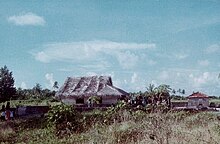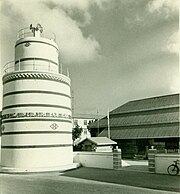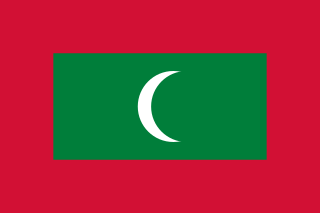
The Maldives, officially the Republic of Maldives, is an archipelagic state and country in South Asia, situated in the Indian Ocean. It lies southwest of Sri Lanka and India, about 750 kilometres from the Asian continent's mainland. The Maldives' chain of 26 atolls stretches across the equator from Ihavandhippolhu Atoll in the north to Addu Atoll in the south.

Islamic architecture comprises the architectural styles of buildings associated with Islam. It encompasses both secular and religious styles from the early history of Islam to the present day. The Islamic world encompasses a wide geographic area historically ranging from western Africa and Europe to eastern Asia. Certain commonalities are shared by Islamic architectural styles across all these regions, but over time different regions developed their own styles according to local materials and techniques, local dynasties and patrons, different regional centers of artistic production, and sometimes different religious affiliations.
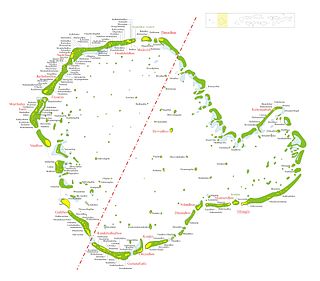
Huvadhu, Suvadive, Suvaidu or Suvadiva is the atoll with most islands in the world. The atoll is located in the Indian Ocean. It is south of the Suvadiva Channel in the Republic of Maldives with a total area of 3152 km2, of which 38.5 km2 is dry land. The atoll contains 255 islands.

Sudano-Sahelian architecture refers to a range of similar indigenous architectural styles common to the African peoples of the Sahel and Sudanian grassland (geographical) regions of West Africa, south of the Sahara, but north of the fertile forest regions of the coast.

Islam is the state religion of Maldives. The 2008 Constitution or "Fehi Gānoon" declares the significance of Islamic law in the country. The constitution requires that citizenship status be based on adherence to the state religion, which legally makes the country's citizens 100% Muslim.

Mughal architecture is the type of Indo-Islamic architecture developed by the Mughals in the 16th, 17th and 18th centuries throughout the ever-changing extent of their empire in the Indian subcontinent. It developed from the architectural styles of earlier Muslim dynasties in India and from Iranian and Central Asian architectural traditions, particularly Timurid architecture. It also further incorporated and syncretized influences from wider Indian architecture, especially during the reign of Akbar. Mughal buildings have a uniform pattern of structure and character, including large bulbous domes, slender minarets at the corners, massive halls, large vaulted gateways, and delicate ornamentation; examples of the style can be found in modern-day Afghanistan, Bangladesh, India and Pakistan.

Fuvahmulah is an island (atoll) in the Maldives. It is under Maldives’ administrative divisions of Gnaviyani Atoll or Nyaviyani Atoll. The inhabitants speak a distinctive form of the Dhivehi language, locally known as "fuvahmulaki baha."
Kondey or Kondē is one of the inhabited islands of Northern Huvadhu Atoll, administrative code Gaafu Alifu.
Manadhoo is the capital of Noonu Atoll in the Maldives. Manadhoo is the third most populous island and the largest natural island in Noonu Atoll.

Argentina is a predominantly Christian country, with Islam being a minority religion. Due to secular nature of the Argentine constitution, Muslims are free to proselytize and build places of worship in the country.

Established on the National Day of the Maldives, the first National Museum of the country was opened on 11 November 1952, by the Prime Minister at the time, Mohamed Amin Didi.
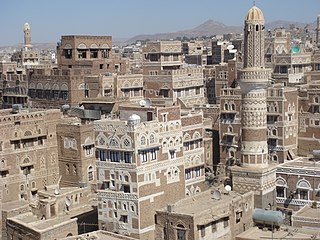
The architecture of Yemen dates back to ancient times, when it was part of a tradition of South Arabian architecture. Developments continued during the Islamic period, displaying both local characteristics and external influences. The historic cities and towns of Yemen are known for their traditional tower-houses.

Buddhism was the predominant religion in the Maldives until at least the 12th century CE. It is not clear how and when Buddhism was introduced into the islands.
The 2008 Constitution of Maldives designates Sunni Islam as the state religion. Only Sunni Muslims are allowed to hold citizenship in the country and citizens may practice Sunni Islam only. Non-Muslim citizens of other nations can practice their faith only in private and are barred from evangelizing or propagating their faith. All residents are required to teach their children the Muslim faith. The president, ministers, parliamentarians, and chiefs of the atolls are required to be Sunni Muslims. Government regulations are based on Islamic law. Only certified Muslim scholars can give fatawa.

The Malé Friday Mosque or the Malé Hukuru Miskiy also known as the Old Friday Mosque is one of the oldest and most ornate mosques in the city of Malé, Kaafu Atoll, Maldives. Coral boulders of the genus Porites, found throughout the archipelago, are the basic materials used for construction of this and other mosques in the country because of its suitability. Although the coral is soft and easily cut to size when wet, it makes sturdy building blocks when dry. The mosque was added to the tentative UNESCO World Heritage cultural list in 2008 as unique examples of sea-culture architecture.

Gen Miskit is the oldest mosque in the Maldives built c. 1300. It is made of coral stone and was built straight after the conversion to Islam.

The Great Mosque of Sana'a is an ancient mosque in Sana'a, Yemen, and one of the oldest mosques in the world. The mosque is said to have been founded in the early Islamic period, suggested to be in 633. While the precise date of construction is unknown, the earliest recorded renovations occurred under Caliph al-Walid I in the early 8th century, implying a possible earlier date of construction. The mosque was reportedly built in part from spolia from the Himyarite-era Ghumdan Palace and from the Axumite Christian Church of al-Qalis that formerly occupied the site. The Great Mosque is the largest and most notable of over one hundred mosques in the Old City of Sana’a.
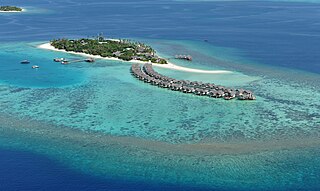
Maamigili is one of the uninhabited islands of Raa Atoll in the Maldives.
The Dhevvadhoo dynasty was a Maldivian dynasty that lasted for nine years, from 1692 to 1701 AD. It was followed by the Isdhoo dynasty.

The architecture of Telangana dates back over two thousand years. The Indian state of Telangana is in the Deccan plateau, bordering the coastal plain of Andhra Pradesh. It has produced regional variants of wider styles of Indian architecture, both in Hindu temple architecture and Indo-Islamic architecture.
